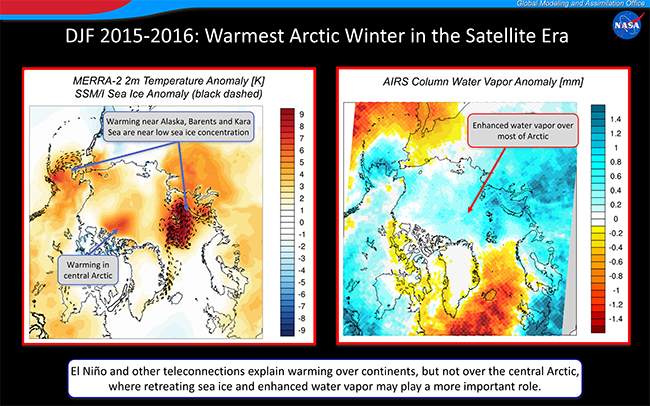DJF 2015-2016: Warmest Arctic Winter in the Satellite Era
The Goddard Institute for Space Studies (GISS) Surface Temperature Analysis (GISTEMP) indicate that for the region of the north polar cap (75°N – 90°N), the 2015-2016 Arctic winter (December-January-February) in the 136 year record. In the upper left, MERRA-2 reanalysis data indicate three foci of warm temperature anomalies: 1) the Barents and Kara Sea, 2) southwestern Alaska, and 3) the central Arctic Ocean. The locations over the Barents and Kara Seas and southwestern Alaska coincide with negative sea ice concentration anomalies, shown in dashed black lines and contoured every 0.1. A third area of warm temperatures occurred over the central Arctic. On 28-31 December 2015, a very strong storm system in the far north Atlantic pushed temperatures to the melting point in close proximity to the North Pole (shown in green; climatology shown in blue).
The period was characterized by anomalous circulation (upper right), with a high pressure located over central Eurasia and extending into the central Arctic. Anticyclonic motion about the high pressure brings warm, southerly air from lower latitudes over the Barents Sea. Teleconnection patterns including El Niño and the North Atlantic Oscillation explain warming over continental surfaces, particularly over North America. Teleconnections do not explain the warming over the central Arctic, where physical processes associated with retreating sea ice and enhanced water vapor play a more central role.
The areas of warmer temperatures coincide with anomalous atmospheric water vapor (lower left) and enhanced downwelling longwave radiation (lower right) from the Atmospheric Infrared Sounder (AIRS) instrument onboard the NASA Aqua satellite. These changes are consistent with increased ice-free, open water and greater evaporation. The water vapor anomalies are shown to have advected throughout the central Arctic. Enhanced water vapor and clouds provide energy for surface warming via increased downwelling longwave radiation. The effects of the anomalous 2015-2016 Arctic winter may continue to be realized over the course of the following year.


